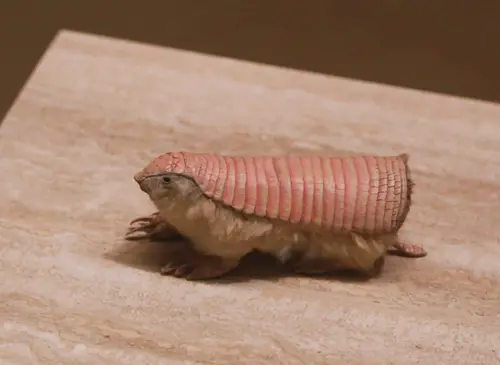The pink fairy armadillo (Chlamyphorus truncatus) is the world’s smallest armadillo species. It is typically found in the dry sandy environments of Argentina. The pink fairy armadillo is the size of a human hand. They are hardly noticed or seen as a result of which scientists find it difficult to assess its behavior in the natural habitat. Fairy pink armadillos do not make good pets.
Pink Fairy Armadillo Facts
Anatomy
- Adult pink fairy armadillo reaches a length of about 90–115 mm (3.5-4.5 in) and the weight averaging 120 g (4.2 oz).
- The armadillo is arguably one of the rarest animals in the world. There silky white fur all over its body. They have brown outer shell on the back and the plates that are made of keratin.
- There are many blood vessels on the plate and all these are pink in color. This is how armadillo earns its name.
- Pink fairy armadillo has powerful claws adapted to digging and burrowing.
- Thanks to the small size, it hides itself within seconds when feel threatened.
Geographic Range & Habitat
- Pink fairy armadillos occur in central Argentina, south of Buenos Aires and north of Rio Negro.
- They make homes in dry habitats including scrubby and thorny vegetation. They seem to prefer habitats that are covered with Portulaca and creosobush plants. Pink fairy armadillos also prefer sandy habitats as well as dunes.
- They adapt to varying temperatures which they must because armadillos live in Mendoza region—a region where both cold and wet seasons are likely to occur.
- It is highly sensitive to any changes in the environment.

Feeding Ecology & Diet
- Pink fairy armadillos are typical insectivores as much of their diet consists of larvae and underground ants.
- While ants are the major source of armadillo’s diet they supplement their diet with snails and worms along with other insects.
- They also eat roots and plant leaves because armadillos can’t find insects and invertebrates.
- The captive armadillos are thought to consume avocado shells, flesh, and water melon.
Behavior
- The pink fairy armadillo is a remarkable digger as it uses front and hind limbs to dig burrows. The massive claws allow the animal to excavate soil very quickly soil.
- They move through the sand as smoothly and fast as fish swims in the sea. However pink fairy armadillo is not able to walk on a hard surface very comfortably. Probably big claws make the walk rather difficult.
- The armadillo has poor vision which is why they seem to rely more on touch or hearing sense.
- Pink fairy armadillo is a nocturnal animal but in captivity they remain active all day round.
- One of the reasons how it can drag its body easily through the sand is that armadillo has torpedo-shaped body. The armadillo’s tail serves to keep the balance and stability while digging underground tunnels. Its tail is completely hairless.
- Predators of fairy pink armadillo are wild boars, domestic dogs and cats.
Conservation Status
Endangered






Leave a Reply